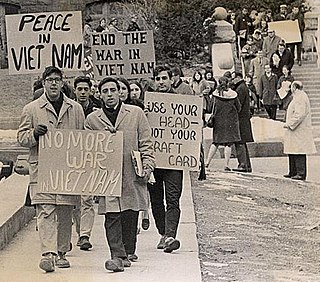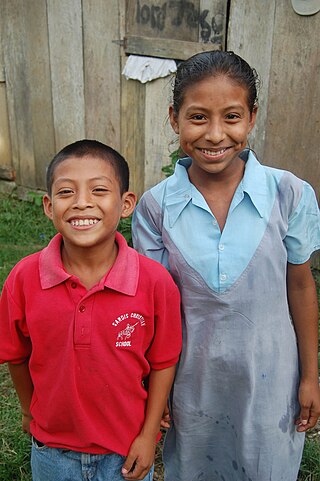
Adolescence is a transitional stage of physical and psychological development that generally occurs during the period from puberty to adulthood. Adolescence is usually associated with the teenage years, but its physical, psychological or cultural expressions may begin earlier or end later. Puberty typically begins during preadolescence, particularly in females. Physical growth and cognitive development can extend past the teens. Age provides only a rough marker of adolescence, and scholars have not agreed upon a precise definition. Some definitions start as early as 10 and end as late as 26, and possibly 30. The World Health Organization definition officially designates an adolescent as someone between the ages of 10 and 19.
Peer pressure is a direct or indirect influence on peers, i.e., members of social groups with similar interests, experiences, or social statuses. Members of a peer group are more likely to influence a person's beliefs, values, and behavior. A group or individual may be encouraged and want to follow their peers by changing their attitudes, values or behaviors to conform to those of the influencing group or individual. For the individual affected by peer pressure, this can have both a positive or negative effect on them.

Youth culture refers to the societal norms of children, adolescents, and young adults. Specifically, it comprises the processes and symbolic systems that are shared by the youth and are distinct from those of adults in the community.

In sociology, a peer group is both a social group and a primary group of people who have similar interests (homophily), age, background, or social status. The members of this group are likely to influence the person's beliefs and behaviour.

Juvenile delinquency, also known as juvenile offending, is the act of participating in unlawful behavior as a minor or individual younger than the statutory age of majority. The term delinquent usually refers to juvenile delinquency, and is also generalised to refer to a young person who behaves an unacceptable way.
Adolescent cliques are cliques that develop amongst adolescents. In the social sciences, the word "clique" is used to describe a group of 3 to 12 "who interact with each other more regularly and intensely than others in the same setting". Cliques are distinguished from "crowds" in that their members socially interact with one another more than the typical crowd. Crowds, on the other hand, are defined by reputation. Although the word 'clique' or 'cliquey' is often used in day-to-day conversation to describe relational aggression or snarky, gossipy behaviors of groups of socially dominant teenage girls, that is not always accurate. Interacting with cliques is part of normative social development regardless of gender, ethnicity, or popularity. Although cliques are most commonly studied during adolescence and in educational settings, they can exist in all age groups and settings.
Egocentrism is the inability to differentiate between self and other. More specifically, it is the inability to accurately assume or understand any perspective other than one's own. Egocentrism is found across the life span: in infancy, early childhood, adolescence, and adulthood. Although egocentric behaviors are less prominent in adulthood, the existence of some forms of egocentrism in adulthood indicates that overcoming egocentrism may be a lifelong development that never achieves completion. Adults appear to be less egocentric than children because they are faster to correct from an initially egocentric perspective than children, not because they are less likely to initially adopt an egocentric perspective.

Ephebiphobia is the fear of youth. First coined as the "fear or loathing of teenagers", today the phenomenon is recognized as the "inaccurate, exaggerated and sensational characterization of young people" in a range of settings around the world. Studies of the fear of youth occur in sociology and youth studies. It is distinguished from pedophobia by being more focused on adolescents than prepubescent children.
Dropping out refers to leaving high school, college, university or another group for practical reasons, necessities, inability, apathy, or disillusionment with the system from which the individual in question leaves.

The role of the children in ancient Mayan civilization was first, and foremost, to help their elders. Once children turned five or six, they were expected to contribute to the family and community. They were treated as young adults and received more responsibilities as they grew older.

Play is a range of intrinsically motivated activities done for recreational pleasure and enjoyment. Play is commonly associated with children and juvenile-level activities, but may be engaged in at any life stage, and among other higher-functioning animals as well, most notably mammals and birds.

Siblings play a unique role in one another's lives that simulates the companionship of parents as well as the influence and assistance of friends. Because siblings often grow up in the same household, they have a large amount of exposure to one another, like other members of the immediate family. However, though a sibling relationship can have both hierarchical and reciprocal elements, this relationship tends to be more egalitarian and symmetrical than with family members of other generations. Furthermore, sibling relationships often reflect the overall condition of cohesiveness within a family.
Social deprivation is the reduction or prevention of culturally normal interaction between an individual and the rest of society. This social deprivation is included in a broad network of correlated factors that contribute to social exclusion; these factors include mental illness, poverty, poor education, and low socioeconomic status. Norms and values.
In linguistics, age-graded variation is differences in speech habits within a community that are associated with age. Age-grading occurs when individuals change their linguistic behavior throughout their lifetimes, but the community as a whole does not change.
Child work in indigenous American cultures covers child work, defined as the physical and mental contributions by children towards achieving a personal or communal goal, in Indigenous American societies. As a form of prosocial behavior, children's work is often a vital contribution towards community productivity and typically involves non-exploitative motivations for children's engagement in work activities. Activities can range from domestic household chores to participation in family and community endeavors. Inge Bolin notes that children's work can blur the boundaries between learning, play, and work in a form of productive interaction between children and adults. Such activities do not have to be mutually exclusive.

Styles of children’s learning across various indigenous communities in the Americas have been practiced for centuries prior to European colonization and persist today. Despite extensive anthropological research, efforts made towards studying children’s learning and development in Indigenous communities of the Americas as its own discipline within Developmental Psychology, has remained rudimentary. However, studies that have been conducted reveal several larger thematic commonalities, which create a paradigm of children’s learning that is fundamentally consistent across differing cultural communities.
Child integration is the inclusion of children in a variety of mature daily activities of families and communities. This contrasts with, for example, age segregation; separating children into age-defined activities and institutions. Integrating children in the range of mature family and community activities gives equal value and responsibility to children as contributors and collaborators, and can be a way to help them learn. Children's integration provides a learning environment because children are able to observe and pitch in as they feel they can.
Aging has a significant impact on society. People of different ages and gender tend to differ in many aspects, such as legal and social responsibilities, outlooks on life, and self-perceptions. Young people tend to have fewer legal privileges, they are more likely to push for political and social change, to develop and adopt new technologies, and to need education. Older people have different requirements from society and government, and frequently have differing values as well, such as for property and pension rights. Older people are also more likely to vote, and in many countries the young are forbidden from voting. Thus, the aged have comparatively more, or at least different, political influence.
Alcohol is a liquid form substance which contains ethyl alcohol that can cause harm and even damage to a person's DNA. "Alcohol consumption is recognized worldwide as a leading risk factor for disease, disability, and death" and is rated as the most used substance by adolescences. Adolescence is a transitional stage of physical and psychological changes, usually a time in a person life in which they go through puberty. Combining these transitional stages and the intake of alcohol can leave a number of consequences for an adolescent.
Social emotional development represents a specific domain of child development. It is a gradual, integrative process through which children acquire the capacity to understand, experience, express, and manage emotions and to develop meaningful relationships with others. As such, social emotional development encompasses a large range of skills and constructs, including, but not limited to: self-awareness, joint attention, play, theory of mind, self-esteem, emotion regulation, friendships, and identity development.









